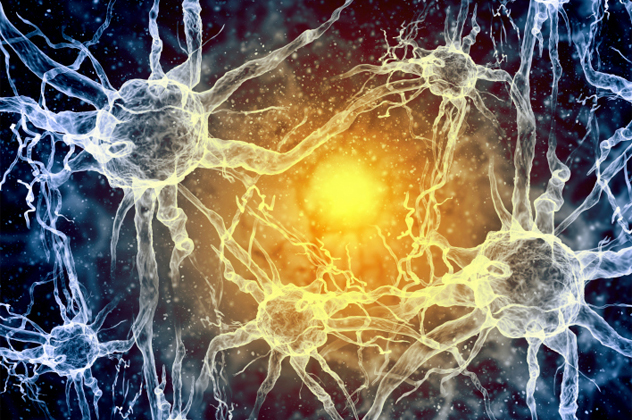 Technology
Technology  Technology
Technology  Humans
Humans 10 Everyday Human Behaviors That Are Actually Survival Instincts
 Animals
Animals 10 Animals That Humiliated and Harmed Historical Leaders
 History
History 10 Most Influential Protests in Modern History
 Creepy
Creepy 10 More Representations of Death from Myth, Legend, and Folktale
 Technology
Technology 10 Scientific Breakthroughs of 2025 That’ll Change Everything
 Our World
Our World 10 Ways Icelandic Culture Makes Other Countries Look Boring
 Misconceptions
Misconceptions 10 Common Misconceptions About the Victorian Era
 Mysteries
Mysteries 10 Strange Unexplained Mysteries of 2025
 Miscellaneous
Miscellaneous 10 of History’s Most Bell-Ringing Finishing Moves
 Technology
Technology Top 10 Everyday Tech Buzzwords That Hide a Darker Past
 Humans
Humans 10 Everyday Human Behaviors That Are Actually Survival Instincts
 Animals
Animals 10 Animals That Humiliated and Harmed Historical Leaders
Who's Behind Listverse?

Jamie Frater
Head Editor
Jamie founded Listverse due to an insatiable desire to share fascinating, obscure, and bizarre facts. He has been a guest speaker on numerous national radio and television stations and is a five time published author.
More About Us History
History 10 Most Influential Protests in Modern History
 Creepy
Creepy 10 More Representations of Death from Myth, Legend, and Folktale
 Technology
Technology 10 Scientific Breakthroughs of 2025 That’ll Change Everything
 Our World
Our World 10 Ways Icelandic Culture Makes Other Countries Look Boring
 Misconceptions
Misconceptions 10 Common Misconceptions About the Victorian Era
 Mysteries
Mysteries 10 Strange Unexplained Mysteries of 2025
 Miscellaneous
Miscellaneous 10 of History’s Most Bell-Ringing Finishing Moves
10 Strange And Obscure Facts About Mental Health
Mental health is one of the most perplexing, fascinating, and concerning issues in modern society. When the human brain malfunctions, it is often a result of complex, interconnected factors involving the whole body. In this fascinating account, we dig deeper and discover some of the most startling, lesser known, and downright weird facts about both well-known and very obscure mental disorders.
10 Schizophrenia Is Connected To The Shape Of Your Mouth

We often put a dividing line between mental health and physical health. Psychiatrists tend to focus on behavior, but a look at physiology might also prove useful in diagnostics. Recent studies suggest that schizophrenia may be correlated with a slightly wider hard palate, which is on the roof of your mouth. What that suggests is that doctors could find ways to look at physical traits to diagnose schizophrenia. Even more importantly, it means that schizophrenia is likely part of a larger developmental disorder than we once thought—one that contains both physical and mental symptoms.
Researchers noticed that these hard palate deformities usually show up in conjunction with mutations and genetic flaws that trigger specific sets of symptoms. Schizophrenia is considered to be an extremely complex illness by the Schizophrenia Association of Canada, which notes the complex, biochemical nature of the illness, and its roots in neurotransmitter and amino acid disruptions. This complexity has led to speculations that schizophrenia might actually be a number of disorders masquerading as a single one.
9 Autism Is Strongly Linked To Seizures

Autism has a history of misunderstandings. In the past, it was considered at different times a type of schizophrenia and the result of neglectful parents. While autism is more clearly understood in the present time, it is still a complex disorder with surprising complications. As a matter of fact, autism might be strongly linked to more serious symptoms than we once thought—while one or two percent of children will statistically experience seizures growing up, up to 38 percent of autistic children are affected by potentially dangerous seizures at some point in their lives.
A prospective study published in the library of the National Institute of Health found that only a third of the children had their first seizure before the age of two. For the rest of them, an epileptic seizure could suddenly occur at any point in life. This work followed the same children for over a decade, and helped to give some credence to the idea that there’s a definite link between autism spectrum disorders and seizures.
8 Shocking Rates Of Mental Illness In Younger Populations

Although it’s not true in all cases, mental illness is often associated with distinctly “unnatural” behavior. However, leading authorities show that being “normal” is less common than we seem to think. According to findings published by the World Health Organization, up to 20 percent of children and adolescents suffer from a mental illness in some form. That’s a surprisingly high number for a population which is usually—and perhaps wrongly—stereotyped as being fit and healthy.
Canadian medical literature notes that young people between the ages of 15 and 24 are most likely to experience mental illness out of any demographic, and mental illness is the second leading cause of premature death or disability in Canada. Commonly reported illnesses include depression, bipolar disorder, and schizophrenia. It’s also not uncommon for drug use to trigger a latent mental disorder—or, conversely, for emerging symptoms of a mental disorder to trigger drug use as a form of self-medication.
7 Mental Illnesses Can Destroy Your Body

Mental illness isn’t just a problem with your mind—it can also lead to serious physical diseases. Most concerning are probably the statistics that point to increased rates of heart disease in mental health patients, for example, while anxiety disorders may cause muscle and back problems. Symptoms of anxiety, along with disorders like Tourette’s syndrome, can also cause physical damage from repetitive stress injuries.
A lot of this can be traced back to a neurochemical imbalance. Toxic hormones released by the endocrine system under stress can cause huge amounts of damage to the tissues and organs in your body. According to several studies by psychiatric services, individuals with mental illnesses such as bipolar disorder, schizophrenia, or depression were 2.6 times as likely to develop cancer. On top of that, studies quoted by Johns Hopkins University noted that those suffering from a serious mental illness had a 50 percent greater risk of hospital visits due to injury than the general population, with a 450 percent increase in death rates from injury compared to the general population.
6 Korsakoff’s Syndrome

Mental illnesses often arise from unexpected places. From a medical standpoint, one of the more interesting mental illnesses is known as Korsakoff’s syndrome. This disorder affects memory in a manner similar to Alzheimer’s, and results from a serious deficiency in thiamine, or vitamin B1. The disorder is largely seen as a complication of excessive drinking, which may deplete B1 levels and cause severe cases of nutrient malabsorption. The distress this puts on the brain can cause confusion, slowness of speech, and forgetfulness.
The most bizarre aspect of this disorder, which is associated with greater degrees of brain damage as it progresses, involves confabulation episodes. In other words, people with Korsakoff’s have been observed making up lies and stories for no reason. But they’re not actually lying—they actually believe the fake stories they’re telling. Korsakoff’s syndrome is usually considered a long-term disorder, although acute thiamine deficiency can lead to coma or death if not treated promptly. AIDS and serious metabolic disorders may also cause thiamine deficiency, with equally serious effects.
5 Stress Shrinks The Brain

We tend to think of mental illness as a malfunction, so to speak, and brain injury as a separate, physical problem. But you don’t have to take drugs or experience physical trauma to suffer brain damage. Brain damage may result from excessive levels of cortisol and other toxic chemicals produced by our still-primitive animal body. A large number of animal species, including humans, hold reserves of drug-like chemicals that provide many short-term benefits to survival through their involvement in the fight-or-flight response.
However, long-term stress, or the presence of a stress-inducing mental illness in modern life, can cause chronic, long-term release of these chemicals. Cortisol—the “stress hormone”—can kill brain cells directly, impair general brain function, and even make the brain smaller through cellular atrophy. Researchers have also found that a reduced ability in elderly patients to control cortisol levels may be linked to Alzheimer’s disease because of the neurological degeneration those increased cortisol levels cause.
4 Autism And Physical Development

Autism is usually seen as a stand-alone mental disorder that has long been a source of controversy among medical practitioners. However, autism incidence also shows a surprising correlation to physical factors, such as birth size and head development. Some studies published in the July 2003 edition of the Journal of the American Medical Association indicated that children with autism tend to be born with slightly smaller heads. However, cranial growth and physical brain development rates then overtake the norm until the head and brain are abnormally large for a time.
They also found that certain brain components in autistic children may be larger than those in control groups. Later, the growth catches up, so that autistic adults have a fairly typical brain-to-body proportion—in other words, autistic children often enter life smaller, but grow faster than other children. Physical factors associated with autism aside, the cause of autism is still a mystery. One study suggests that autism rates are higher in US counties with more rainfall. Despite the connection, they still haven’t discovered why that’s the case. It could be something as simple as the fact that with more rain, children spend more time exposed to household chemicals indoors.
3 Depression Is Surprisingly Environmental

Depression is usually seen as some form of internal imbalance of the mind. However, studies suggest that depression in human beings may be profoundly influenced by our living environment. According to a 2011 study in the Nature journal, city dwellers suffer from a rate of depression that’s 39 percent greater than rates of depression experienced by rural dwellers.
Decreased levels of essential fatty acids through dietary factors, such as low fish intake, have also been correlated with depression. In addition, urbanites are 21 percent more likely to have anxiety, while rates of schizophrenia are nearly doubled in cities. Scientists noted that city dwellers had increased activity in the cingulate part of the brain, which affects the ability of the brain to regulate stress. It appears that continued strain from urban environments stresses out the body, leading to mental health challenges in some people.
2 Pure Obsessions

Obsessive-compulsive disorder affects a significant percentage of the population. However, it is likely misunderstood in many cases, because only the visible signs are well known. In fact, OCD is often present in a more insidious form known as pure obsessions, where violent or disgusting thoughts flood the brain and cause significant distress. A person with this widespread—but underreported—form of OCD may experience repeated thoughts that shock even them, and often have to try to “change the channel” mentally to get rid of the thoughts.
This so-called “Pure O” form of anxiety disorder exists where no obsession-related action occurs. It’s usually characterized by something incredibly violent, like a random thought to pull out a knife and stab their coworker. They don’t want to do that, but the thought runs through their heads anyway. Usually, they’re just as disgusted by their thoughts as anyone else would be. At the same time, people suffering from “Pure O” don’t compulsively repeat actions, which is what you usually picture when you think of someone with OCD.
1 Nerve Damage, Mental Health, And Socialization

As we’ve mentioned several times, mental illnesses could be far more physical than once thought. Researchers have already determined that reduced production of myelin, a nerve-protection fiber, is associated with degenerative neurological disorders such as multiple sclerosis. In recent studies at the Graduate School of Biomedical Sciences at Mount Sinai School of Medicine, loss of myelin sheathing on nerve fibers has been found to be linked to the development of mental illnesses.
Myelination is a highly physical, electromechanical component of the nervous system. It’s responsible for insulating nerve fibers and allowing efficient transmission of brain signals. While mental health studies often put a lot of attention on the neurotransmitters themselves, it seems that the condition of the “wiring” is also pretty important. Even stranger is the fact that myelin damage may be caused by environmental and social factors. Studies done on mice indicate that myelin production can become impaired as a result of social isolation. The effects are not limited to young mice, either—in the studies, the development and maintenance of myelin levels in adult mice was impaired as well.
Christopher Stephens is a graduate student of science and busy freelance writer and naturalist on Vancouver Island in British Columbia. He is the birding tour leader for Pacific Rainforest Tours and writes for Island Healthworks.








